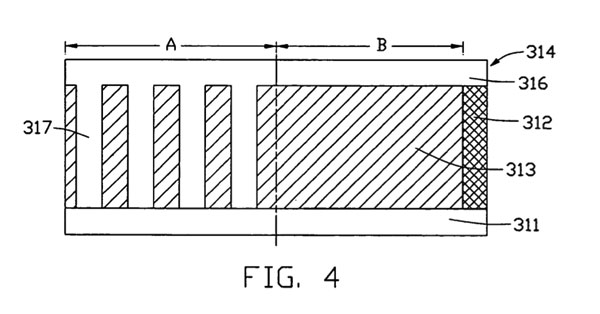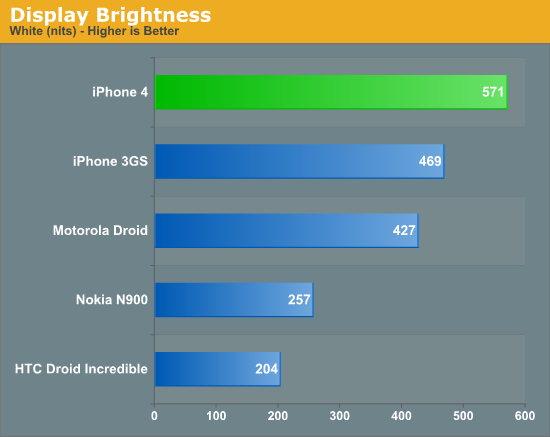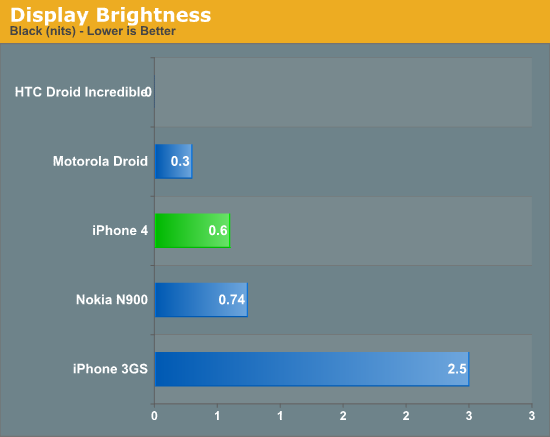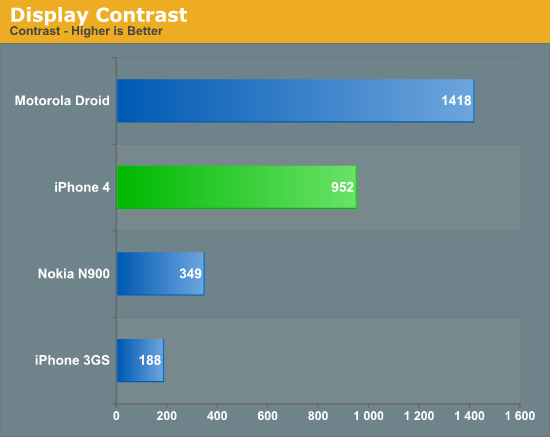Apple's iPhone 4: Thoroughly Reviewed
by Brian Klug & Anand Lal Shimpi on June 30, 2010 4:06 AM EST- Posted in
- Smartphones
- Apple
- iPhone 4
- Gadgets
- Mobile
More Display
It's obvious how Apple settled on 960x640; it's four times the resolution of the previous iPhones. However, instead of decreasing text size, iOS 4 scales appropriately, and the size of everything remains the same. The result is that there are small details everywhere that pop out. Apple's icons on the home screen are the first that really pop out, and new iOS 4 optimized applications will bring that increased detail as developers add higher resolution artwork.
The display panel itself uses a subset of IPS (In Plane Switching) display technology called Fringe Field Switching (FFS). Where IPS switches the crystal polarization in the plane of the display with two opposing electrical substrates composed of semi opaque metals (which decreases transmission and viewing angles), FFS uses considerably less metal by arranging the electrodes in a comb like structure.

See that - it almost looks like a comb. Or an impulse train. Or Dirac comb. So many combs.
The result is that there's considerably less metal in back and in front of the pixel, resulting in much higher transmission of light through the display, and higher brightness for a given backlight level. Using FFS to drive pixel switching is critical here because of the high dot pitch in the iPhone 4's display.
The other interesting difference between iPhone 4's retina display and previous displays is that the digitizer is in optical contact with the display itself. There's no longer an air gap, and as a result, no longer any opportunity for dust to gradually work its way inbetween. Over time, I've noticed a few dust specks creep in on my 3GS, it does happen. The digitizer and display panel are essentially laminated together. The added benefit is that fewer material interfaces results in fewer internal reflections - think the "super" in Super AMOLED but applied to TFT. That's what Apple has done here.
Apple is using Corning's Gorilla glass which touts hugely increased scratch resistance and robustness. Both the front and back of the iPhone 4 are that same type of glass. I've noticed a few superficial scratches (called sleeks) that have appeared on the back, but really the true test will be how the phone looks after 6 months in the pocket. It's interesting that the iPhone capacity markings have disappeared from the back of the phone - no doubt this was done so Apple could make one part and one part only for each color.
The rest of the details are in the specifications. Apple advertises increased brightness of 500 nits and a contrast ratio of 800:1. We measured, and our iPhone 4 exceeded specs at 571 nits and just under 1000:1 contrast ratio.



Note that the HTC EVO 4G is missing as Anand has it, but it's on its way to me. As soon as I get it, I'll measure display brightness, black point, and contrast and update these results. In addition, the HTC Droid Incredible (and thus Nexus One) contrast is effectively infinity by the way we calculate, due to pixels being completely turned off in the black state. In addition, I'm led to believe that the AMOLED's PenTile grid throws off our numbers when measuring brightness. I've run and rerun this test, it keeps coming up that way.
Next to the iPhone 4, the 3GS display really shows its age. It leaks light when displaying black, with an absurdly high black point of nearly 3 nits. Just looking at the lock screen on the iPhone 4 next to the 3GS it's readily apparent how much better blacks are. iPhone 4 easily bests the 3GS but still isn't quite as contrasty as the Incredible or Nexus One AMOLED displays, or the IPS in the Motorola Droid. You do get higher resolution and brightness, however, but nothing is free.
Going from the iPhone 4's display back to the 3GS is pretty painful, but going back to even relatively high dot pitch displays on the desktop is painful as well. Even on the "high resolution" MacBook Pro with 1680x1050 display, displaying an iPhone 4 screenshot at native resolution uses up 91% of the height. If there's one thing I hope the iPhone 4 display does, it's generate demand for 300 PPI level desktop displays - the era of 110 PPI displays being the norm needs to end now.










270 Comments
View All Comments
Griswold - Wednesday, June 30, 2010 - link
Lets be honest, he has only very limited means to meassure the problem. To get to the bottom of this, it needs to be meassured in a HF lab.samspqr - Wednesday, June 30, 2010 - link
"The fact that Apple didn't have the foresight to coat the stainless steel antenna band with even a fraction of an ounce worth of non-conductive material either tells us that Apple doesn't care or that it simply doesn't test thoroughly enough."I find it really funny that they would never catch this specific problem because of them just being apple: if their engineers are not as good as anand is (as in thinking "that's gonna be a problem" right after hearing the description of the antenna), and if THE FIELD TESTERS HAD THEIR PHONES DRESSED AS A 3GS BECAUSE OF PARANOID ISSUES, this kind of problem can only slip through
The0ne - Wednesday, June 30, 2010 - link
I think Anand was a little light on this topic. As an multi-discipline engineer myself this type of problem with the Antenna SHOULD NEVER had happened. It can only happened due to decisions that did not properly address it. This is not rocket science to engineers. If anything, testing WOULD HAVE discover the problem and yet it's in the finish product. Quite sad if you ask me.For example, why put a ferrite clamp on the end of the cable instead of designing it into the PCB . The only reason I can see why we did this was due to lack of time and we severely paid for it by having products become defective because the ferrite would pull the cables loose from the connectors.
deppbv78 - Wednesday, June 30, 2010 - link
I'm really disappointed at the lengths taken by AT to justify that iP4 losing signal as not a big deal...If it was any other product from any other manufacturer, I'm sure you'd not have gone to such lengths to justify the signal drop and just concluded that the phone has serious antenna problems. I'm not understanding why is it so difficult for anyone just provide an unbiased view of the product.I have HTC Hero & Touch Pro both of which lost a bar or two (with fluctuations) when cupped tightly. However, it was always just 1-2 bars and never went down like iPhone 4 does from 5 bars to 0. This continuous loss of signal is the problem. Justifying it telling that all phones lose signal is not right, as every other phone (including 3GS) loses signal temporarily and then stabilizes unlike iPhone 4.
No wonder the iPhone 4 is engineering marvel, but that set aside it is also true that the design has created issues as well and the reviews need to acknowledge it and not justify it
geniekid - Wednesday, June 30, 2010 - link
HTC Incredible owner here. I think AT successfully showed that the antenna issue is NOT a big deal and their methods for doing so are sound. I share your suspicion that maybe they wouldn't have made such a significant investigation if it had been another phone, but let's not accuse them of mistakes they haven't made yet.bplewis24 - Wednesday, June 30, 2010 - link
I have a sincere question though. Does this test really successfully show the antenna issue is NOT a big deal, or does it simply show that it's not a big deal in the utmost ideal conditions?Sometimes the article is difficult to decipher in terms of understanding who is saying what, but upon my initial reading I take it Brian did the testing of the antenna in Arizona. By his own admission (from my understanding), he lives there because the reception is absolutely stellar and about as good as it can possibly be.
Again, from what I can tell, it is under those conditions that he conducted the attenuation signal loss comparisons. If it still drops down to 1 bar and comes reasonably close to dropping calls under the best possible conditions, how does it react under "average" conditions? Other people are reporting dropped calls for a reason. Is Brian's test the norm or an outlier?
Please correct me if I've read this article wrong.
Brandon
anactoraaron - Wednesday, June 30, 2010 - link
My understanding is you are partially correct in assuming (which is what I interpreted from your post) that under "normal" or "average" conditions you will go to one bar - which with the improved reception even at 1 bar you are still fine - OR will drop signal completely.This is also the reason why they say "At the bare minimum Apple should give away its bumper case with every iPhone 4 sold."
Again, fantastic in-depth review.
strikeback03 - Thursday, July 1, 2010 - link
Well, he said the location he lives in has stellar reception. But he also said he drove around for a day testing, which implies to me that he found somewhere with a stable, "average" signal and did some testing there, then probably went somewhere with a "poor" signal and did some more, etc.bplewis24 - Friday, July 2, 2010 - link
@strikeback03Correct. And in driving around to the less-than-stellar areas showed the phone dropping down below -107dB for reception when showing less than 2 bars. And this is on the low end of the reception spectrum as described earlier in the article. So it's pretty clear that the antenna does INDEED show poor signal strength in average or less than average areas when the "death grip" is applied.
That is the determining factor. That determines that the design is defective and flawed. If it was not designed that way, when in average or below signal areas, the reception would still be average or below, and not well below because of the way you hold the phone.
However, the article skirts this and attempts to present it in a way that shines the best possible light on Apple and their defective design. Big disappointment in terms of an objective review.
Brandon
geniekid - Wednesday, June 30, 2010 - link
The article made it clear that bars are a misleading way of measuring call quality/reception. In practice, it was noted that call quality/reception is improved/equal to the 3GS on the 4, regardless of bars (raw signal power).Who cares if you have 1 bar all the time if you're still making calls better than someone with 4 bars?
HTC Incredible owner here.